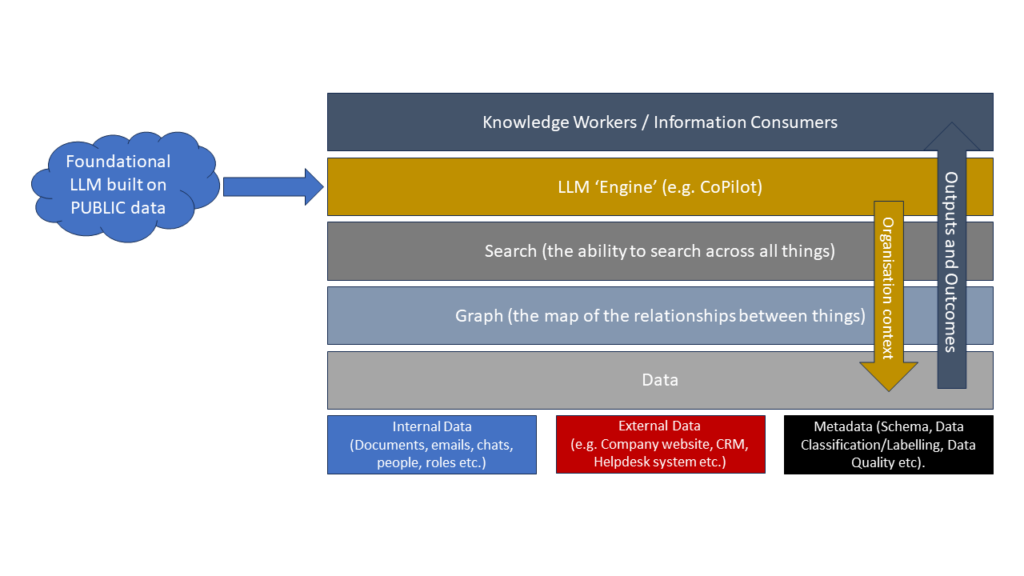
Drucker’s Data Legacy

Peter Drucker’s data legacy is often overlooked. But as one of the most profound visionaries in the modern disciplines of management, Drucker foresaw many of the practical and pragmatic challenges of managing data that organisations struggle with today. Going back to the 1950s he famously praised IBM for delivering fantastic service to its customers in systems analysis and data gathering. The vinegar with the sugar came almost as an aside: “I wish you knew more about what to do with information once you get it, but that is a private wish“.
Writing in 1998, Drucker summarised his early contributions to the introduction of computerisation in a characteristically blunt fashion.
The computer would, in short order, revolutionize the work of top management. It would, we all agreed, have its greatest and earliest impacts on business policy, business strategy, and business decisions.
We could not have been more wrong.
Value Creation
Of course, what Drucker was referring to was the impact of computerisation on the operations functions of organisations, reducing the drudgery of processing information, improving logistical efficiencies, and improving the management of costs. But, Drucker tells us, these are not the policy and strategy level decisions which he and others considered information management and computerisation to be enabling. They are still tied to classic objectives of operations and cost/benefit maximisation.
Fast forward to today and we see the same challenges still plague the implementation of new capabilities for managing data. Whether it is the education establishment that is looking to adopt machine-learning driven processes to steer learners through a “learning path” based on their interests and objectives, or a municipality deploying “Smart Cities” technology to improve the urban landscape, the same issues Drucker spotted almost 30 years ago remain endemic.
The educator is deploying technology to improve the perceived value of their courses to learners and to reduce the ‘cognitive cost’ that students would pay trying to figure out their own learning plans from a menu of options. This means the educator can provide short courses, assess demand and level of interest. They can avoid the investment cost and risk of developing larger courses that might not have a market. And they can sidestep the problem of education products that take so long in gestation that they miss the market. The development of ‘self-service’ learning reduces the administrative overhead for delivering courses.
But all of this is essentially cost avoidance.
The municipality can deploy sensors of various kinds to measure many wonderful things in the urban environment. No more do they need to deploy people with clickers and clipboards to measure footfall on a street. Garbage bins can phone home to the municipal waste collectors to tell them they are getting full, optimising collections and resources. The firehose of data that can be enabled from clever technology placed in the urban or rural environments is data available at a cost of acquisition that was unimaginable barely a decade ago.
But again, this is cost avoidance and operational efficiency. The significant leap comes when that data is used to inform policy and strategy.
But none of the fancy technology works without some fundamental data building blocks being in place. And the admonition to IBM from Drucker from seventy years ago rings in our ears…
I wish you knew more about what to do with information once you get it, but that is a private wish
Data Legacy – Legacy Data
And we can’t ignore the fact that organisations still have legacy data, and historic files. This was a topic discussed at length on a recent National Archives seminar in respect of the management of the Public Record in Ireland and elsewhere. The general gist of a common complaint: people have forgotten how to do filing and the adoption of electronic records means that there is a data governance and data management crisis looming in the preservation and management of critical data.
Just as Drucker predicted, we have seen a proliferation in the use of computers and digital technology across a variety of sectors. Vast amounts of data are produced. But without clear thinking and strategies about what is to be done with the information once it is obtained, recorded, and processed, organisations can struggle to tame the data beast. Last week I wrote about this in the context of SMEs and the handling of accounting data and business records when companies change accountants or accounting platform. It is the unglamorous value of small things, but all to often at scale.
And as organisations adopt new ways of gathering and processing data from a multitude of sources and formats, the value in the small things becomes significant. Because those small things help us understand the meaning and purpose of data.
The Meaning and Purpose of Data
In his 1998 article for Forbes ASAP, Drucker described the evolution of computing in businesses and diagnosed the first key problem… computers were put to use first and foremost to process the accounting data of the organisation. Because it was the only data available at scale. But Chief Information Officers realised that other data was what was needed by their colleagues.
But they did not, as a rule, realize that what was needed was not more data, more technology, more speed. What was needed was to redefine information; what was needed was new concepts.
Drucker highlighted that in previous Information Revolutions, such as the introduction of printing, the controllers of the technology eventually became tradesmen serving those who defined and managed the meaning and purpose of the information that was recorded. He predicted that this would become the eventual fate of the technologists, as organisations and society shifted their attention to the “I” in “IT” once more in the current information revolution.
The next information revolution asks, What is the MEANING of information, and what is its PURPOSE? And this is leading rapidly to redefining the tasks to be done with the help of information, and with it, to redefining the institutions that do these tasks
The role of Data Governance in a Connected Work World
Understanding the meaning and purpose of data is, therefore, an essential aspect of every executive’s role in the modern information revolution. After all, with the incredible tools at our disposal through cloud computing and other technologies it is very easy for any executive at any level in an organisation to develop data gathering and data processing capabilities that even a decade ago would have required a good degree of coding experience.
Of course, Drucker predicted this back in 1966 in his book The Knowledge Worker.
Every knowledge worker in modern organization is an “executive” if, by virtue of his position or knowledge, he is responsible for a contribution that materially affects the capacity of the organization to perform and to obtain results.
This means that, today, staff working with data and even the basic tools for data management like email, document editing tools like Microsoft Word, spreadsheets, or simple database software, can have an impact on the capacity of an organisation to perform and to obtain results. We are all knowledge workers to a greater or lesser extent. And the knowledge we have of the meaning and purpose of data is critical to our ability to properly execute our “Data Executive” functions. The democratisation of data in the organisation means that we are now having to deal with the policy and strategy questions that Drucker called out 70 years ago.
This is made even more challenging in a Connected Work World. The Pandemic Pendulum will never swing back to where it was in respect of the performance of knowledge work. We will continue to have a hybrid work model across a vast swathe of sectors. The disruption that Drucker foresaw from the information revolution has happened and no industry will be unaffected.
But this means that the fundamental building blocks for data, the unglamorous small things, need to be given even more attention by organisations to ensure we don’t drown in data. If we do not do these things, it will be difficult to sustain Connected Working and develop resilience against external threats to our data (e.g. ransomware attacks), ensure compliance with legislation and regulatory requirements, or simply keep a lid on the growing cost of non-quality data and redundant records.
The Unglamorous Things
- Data Definition – organisations need to consciously define the meaning and purpose of data. What are the concepts that need to be managed to deliver on the business objectives of the organisation and create value. this includes the fundamentals of metadata definition for both structured and unstructured data. (We’re working on this with a number of clients at the moment).
- Data Literacy – more than just teaching people how to use the latest toys, we need to develop a deeper understanding of data in knowledge workers of all levels. This is not a one-size-fits all proposition and will need to be planned for. (We’re working with a few clients on data literacy strategies and developing models for data literacy).
- Data Strategy – all too often the strategy of organisations is that of the Underpants Gnomes in South Park. First we get the technology. Then something. Then PROFIT!! It’s not glamorous, but digging into what data capabilities you need to have and develop to support your business goals to create value. We need to understand what the “something” is that the Underpants Gnomes never quite figured out. (We’ve worked with a number of clients recently on Data Strategy work focussed on business value delivery).
- Data Quality – how good is your data? What is the hidden cost of non-quality in your data? Is the data fit for purpose? Most organisations burn between 10% and 35% of turnover on poor data quality. Fixing some basic things can have a significant impact, but it requires that knowledge workers are aware of the meaning and purpose of data. (This is one area where we often start with clients, but tackling it can trigger a focus on other areas of opportunity for improvement).
- Records Management – it’s definitely not glamorous, but simple things like file naming conventions, file plans, data retention schedules and other non-sexy things are the bedrock of good data management and enable better results from technology investment. Moving manure from one bucket to another doesn’t magically turn it into gold. The same is true for records and data.
Conclusion
To paraphrase Tom Peters: The simple is hard and the hard is simple. It sounds simple for Drucker to discuss the meaning and purpose of data as a key source of competitive advantage and value creation. But achieving that can be hard. However, many of the things that appear hard are, ultimately, simple if we remember that the knowledge worker is a person and Drucker’s data legacy is the empowerment of knowledge workers to contribute in a positive way to their organisations and to society.


